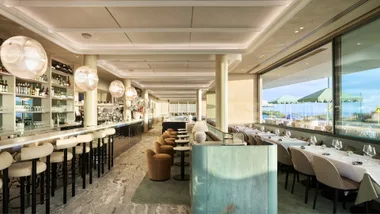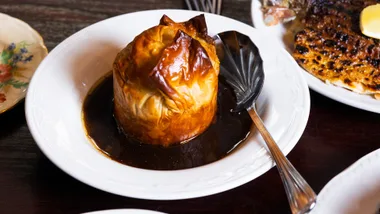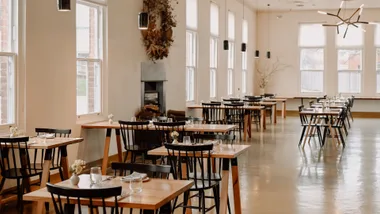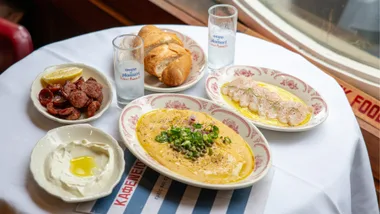AKACHOCHIN
33 South Wharf Promenade, South Wharf, (03) 9245 9900, akachochin.com.au.
Licensed.
Cards AE MC V EFT.
Open Lunch noon-4pm daily, dinner 6pm-late daily.
Prices Shared dishes $6-$30.
Vegetarian Yes.
Noise Background.
Wheelchair access Yes.
Plus Paul Mathis doing Japanese again.
Minus The muddled entrance arrangement.
In typical energetic style, restaurateur Paul Mathis has burst back onto the Melbourne dining scene, opening six new businesses in short succession. He was scarce for a few years following the closure of the well intentioned but badly located eatery 100 Mile Cafe, and so this sudden proliferation of businesses that range from coffee specialist and pizza barn to Euro diner and Japanese tavern could be read as a lot of pent-up energy.
And so it may be, but Mathis has always been a man with a plan, and while his ideas may bound about like Tigger, sometimes ahead of the pack, sometimes over to one side of it, there’s never anything slapdash in the way he goes about things. He’s an expert at putting his ideas decisively into practice.
Akachochin is the Japanese tavern element of the current Mathis equation, located in a former boatshed at South Wharf, a new precinct that’s proving surprisingly successful (particularly in contrast to nearby Docklands). The restaurant is named for the red paper lanterns that hang outside small, izakaya-like eateries in Japan – and that mark the location of Akachochin. Entry to the restaurant, however, is through yet another of Mathis’s restaurants in the same boatshed, The Sharing House.
It’s a little confusing and, as far as first impressions go, not brilliant. Once you’ve been guided past The Sharing House’s lurid Lego bar and into the calm timber and marble world of Akachochin, however, where the staff sing out “irasshaimase” when you enter and there’s the reassuring glisten of fish in the glass case atop the white marble sushi bar running the length of the room, muddled entrances recede into the background.
Mathis has done Japanese before – Taxi Dining Room, Chocolate Buddha, 100 Mile Cafe all leaned to the land of the rising sun to greater or lesser degrees – but Akachochin is probably the simplest and most straightforward of the attempts. And there’s an absence of the proselytising to change how, why or what we eat that characterised some of his past businesses. Akachochin is more a solid, authentic Japanese eating and drinking experience, albeit one that says Melbourne as emphatically as it says Tokyo.
The large, open space with its backlit plywood panelling, soaring A-frame roof with exposed insulating foil, two-tone timber chairs, marble-topped tables and raised seating area around the sushi bar (so you can sit on a chair rather than a stool) has a crisp graphic quality – all light and simplicity and natural materials bent to the will of a creator with a keen eye for a clean line. The design language is obviously Japanese, but it’s a matter of inspiration rather than slavish reproduction and has an unmistakably modern bent.
The menu reflects the same approach: former Nobu chef Kengo Hiromatsu creates a series of dishes all designed to be shared while sticking within the basic Japanese Australian restaurant parameters: offering a little bit of lots of things, from sushi and udon to yakimono and agemono. He’s an excellent cook and skilled at putting a subtle, clever twist on some very familiar Japanese dishes.
Take his version of chawan mushi, for example. It’s normally served in a small bowl designed for one person, but Hiromatsu, following the Akachochin mantra, has designed a larger version of the savoury egg custard so it can be shared. It looks beautiful, a little like an ink-on-rice-paper drawing of a whole shiitake mushroom with a flower pattern cut into it surrounded by frond-like leaves of kikuna – chrysanthemum leaves – and bright yellow flecks of yuzu skin, all set into the surface of the custard. Underneath, there’s a veritable party of ingredients – eel, crab, prawn, scallop, chicken, ginko nuts – making this most ethereal, delicate-looking dish more like the kind of robust comfort food you’d want to tuck into after a long hike.
Hiromatsu plays a similar game with agedashi tofu, the ubiquitous deep-fried tofu dish that normally sits in a slightly sweet dashi- and soy-based sauce. All those elements are present but the tofu is made in-house with the addition of eggs so that it’s rich and more custard-like, and the sauce has been thickened and has shiitake and kombu in the mix. The whole thing is topped with a fortifying combination of Japanese mountain vegetables – fern leaf and sprouts, bamboo leaves and shoots, various small mushrooms – that have been marinated and then cooked in shiitake stock with a julienne of seaweed.
Sometimes the modern twists are a little more challenging than comforting. It’s not uncommon for restaurants in Japan to use cheese in ways that can puzzle Westerners, but sometimes the wackiness of the combinations can be revelatory. Not so here in the case of the deep-fried spring roll filled with prawn, pumpkin and blue cheese, whose flavours come across a little like people standing around at a party with nothing to say to one another.
Then again, at the dessert end of the meal Hiromatsu has something of a cheese redemption when he teams mascarpone with tofu and some umeshu – plum wine – to make a mousse that comes across both light and rich. It plays beautifully with the deeply flavoured raspberry sauce poured over the top and with the umeshu-poached pears splayed over to one side.
There’s umeshu to drink too – five types of the plum wine in all, including a frozen version that’s like a slushie – but really what you want to get stuck into here is the sake. The list of rice wine is lengthy, though not intimidatingly so, its prices are democratic and its tasting notes clear and concise. Still, for the uninitiated trying to make sense of the different weights, regions and styles, it might seem all too hard, but the staff are excellent at calming any anxieties and at recommending a sake to match the occasion. Usually they’re on the money and once you’ve polished off, say, a chilled Ginjo Hana – a beautifully dry number with some floral wafts and a bit of fruitiness – with sushi, you’re going to be hard-pressed to come up with another beverage that’s going to do the job quite so well. (If you must, there are some cracking Japanese beers and the wine list from next door is on call.)
The sushi and sashimi at Akachochin are solid without being extraordinary. They’re certainly beautifully fresh, chosen with an expert eye and treated to some impressive knife skills. If there’s King George whiting available, order it for its wonderful firm texture and real affinity with wasabi. It’s also worth keeping an eye out for the beautiful scallops – fat Japanese numbers – and sea eel. The availability of each particular species varies a lot, a reassuring sign that the chefs are keeping an eye on the quality, though the constant presence of farmed salmon is a reminder that there’s also a bottom line involved with all of this.
One of the best raw fish dishes on the list is the Hiramasa namerou, a version of tartare: kingfish is tossed in a bit of olive oil and soy sauce, chopped and thrown into a vibrant mix that includes pickled wasabi stalk, spring onions and a sweet and salty miso paste. The slightly fiery, rich, voluptuously textured tartare comes with some big, beautifully misshapen white crackers made from rice that’s boiled to congee consistency, rolled out and dried on a baking sheet in the oven, then deep-fried so it puffs up like a prawn cracker.
Simple things are done well here too. Wagyu, chicken and pork belly are given the smoky grill treatment and then served with a spicy house-made teriyaki sauce. Wagyu tataki comes with green chilli paste, fried leeks and crisp fried flecks of chilli skin. Ox tongue, thinly sliced, is fried then quickly grilled and served with hot leek oil.
There’s plenty for the deep-fried brigade to get excited about too, especially the chicken wing dumpling, which is already inspiring return visits for its over-the-top combination of chicken dumpling mix (minced chicken, cabbage, sesame oil, soy, et al) stuffed inside the skin of a chicken wing then thrown into the deep-fryer. It’s the sort of dish that could inspire a cult. Similarly, the deep-fried potato cake stuffed with quail meat and served with a deep-hued, gorgeously flavoured masterstock-marinated quail breast and wing is one to draw addicts.
The attention to detail at Akachochin – the house-made stocks and sauces, the choice of (gluten-free) tamari or soy sauce on every table, the tiny spoon-shaped biscuits that come with dessert – is impressive, but when you think that Paul Mathis is also bouncing around to five other new businesses, it starts to look remarkable. There’s a strong and dedicated team on hand, especially in Kengo Hiromatsu, but there’s also evidence of hard-won experience and clear vision in the clean-lined room. Whatever the equation, it’s good to have Mathis back in the game.
 Marcel Aucar
Marcel Aucar










